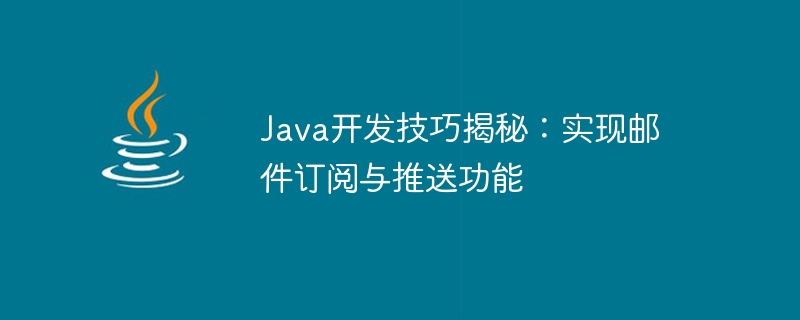
Java development skills revealed: Implementing email subscription and push functions
In the era of information explosion, subscription and push functions have become indispensable in various applications part. Whether it is news information, e-commerce or social platforms, they are all inseparable from the support of email subscription and push functions. This article will introduce some Java development techniques to help developers implement efficient email subscription and push functions.
1. Implementation of email subscription function
The email subscription function mainly includes several key steps such as user registration, subscription, unsubscription and email sending. The following is a detailed introduction to each step:
- User registration: User registration is the first step in realizing the email subscription function. Developers need to design a registration page where users enter relevant information, including name, email, etc. After the user fills in the information, the information is saved in the database and a unique user ID is assigned to the user for subsequent subscription and unsubscription operations.
- Subscription: After successful registration, users can subscribe to emails. Developers need to design a subscription page where users can choose content to subscribe to, such as news categories, merchant promotions, etc. After the user selects the content, the subscription information is saved in the database and associated with the user ID.
- Unsubscribe: Sometimes users may no longer need to subscribe to certain content, so it is necessary to provide the function of unsubscribing. Developers can design an unsubscribe page where users can choose content they no longer want to subscribe to and update the unsubscribe information to the database.
- Email sending: When the content subscribed by the user is updated, the updated content needs to be sent to the user via email. Developers can use the JavaMail API to implement the email sending function. Before sending an email, you need to obtain subscription information from the database, including the user's email address and subscription content. Then use the JavaMail API to construct the email content and send it to the user.
2. Implementation of email push function
The email push function is similar to the subscription function and also requires several steps such as user registration, subscription, unsubscription and email sending. Each step is introduced in detail below:
- User registration: The user registration step is the same as the first step to implement the email subscription function.
- Subscription: After the user successfully registers, he can subscribe to the email push. Unlike the email subscription function, the email push function can push messages based on the user's interests and behavior. Developers can push personalized content to users by counting users' browsing records, purchase records and other information.
- Unsubscribe: Users can unsubscribe from email push as needed. Developers can design an unsubscribe page, where users choose to no longer receive content and update the unsubscribe information to the database.
- Email sending: Similar to the email subscription function, the email push function also requires the use of JavaMail API to implement email sending. Before sending an email, subscription information needs to be obtained from the database and the content to be pushed is determined based on the user's interests and behavior.
3. Optimize the performance of email sending
After implementing the email subscription and push functions, developers can also optimize the performance of email sending through the following aspects:
- Mail queue: In order to avoid server pressure under high concurrency conditions, a mail queue mechanism can be introduced. Developers can use message queue technology to implement email queues, store the email information to be sent in the queue, and then use the background process to send the email.
- Asynchronous sending: Email sending is a time-consuming operation, and asynchronous sending can be used to improve performance. Developers can use Java's thread pool mechanism to put email sending operations into the thread pool for processing.
- Scheduled sending: Sometimes users do not need to receive emails immediately, and can design a scheduled sending function. Developers can use the scheduled task framework to regularly scan the subscription information in the database and add the email information that needs to be sent to the email queue.
Summary:
Email subscription and push functions are an integral part of modern applications. Through the Java development skills introduced in this article, developers can easily implement efficient email subscription and push functions. In addition to basic subscription, unsubscribe and email sending functions, performance can also be improved by introducing optimization methods such as email queues, asynchronous sending and scheduled sending. I believe this article will be helpful to Java developers in implementing email subscription and push functions.
The above is the detailed content of Java development skills revealed: implementing email subscription and push functions. For more information, please follow other related articles on the PHP Chinese website!






